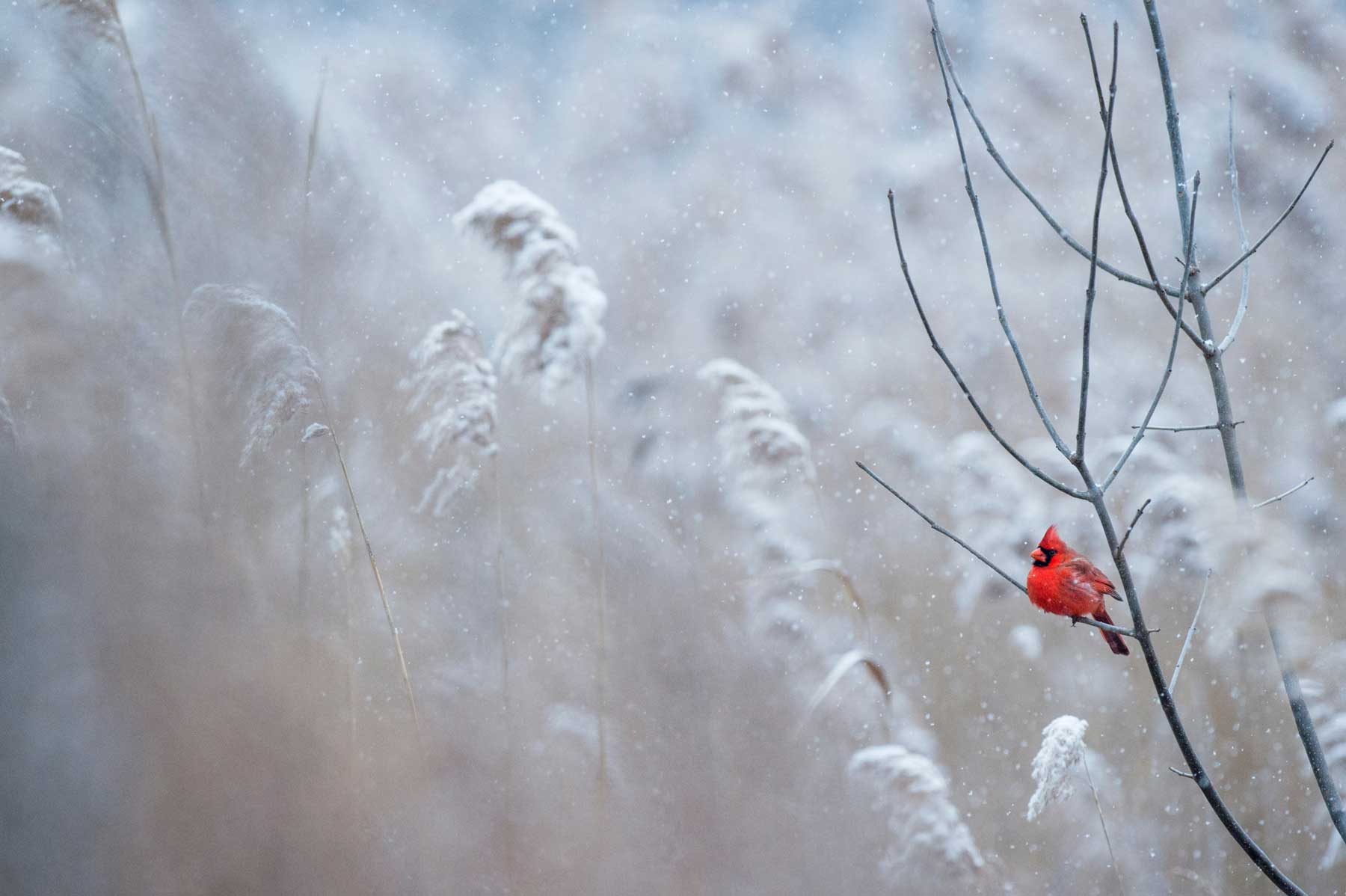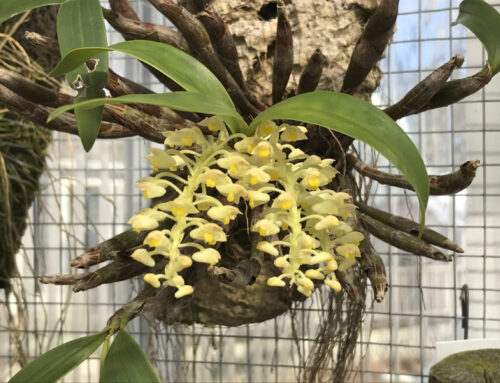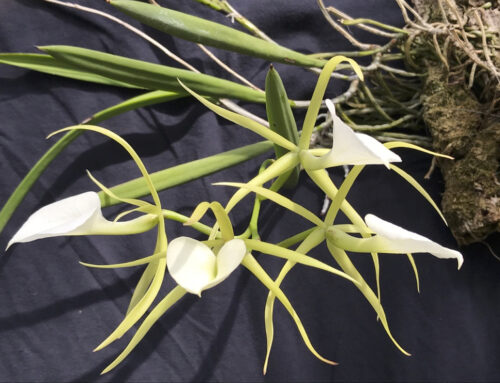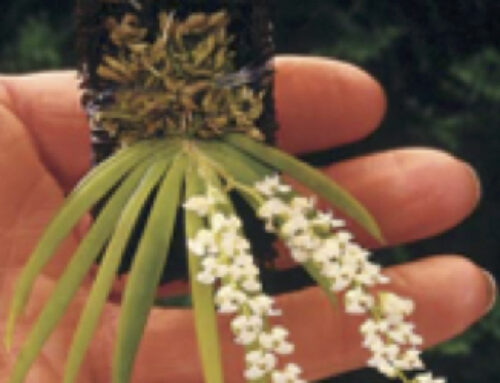By Susan Jones
The onset of shorter days and longer, colder nights heralds winter’s arrival. Many factors play into keeping your orchids happy and healthy through this time — finding the right combination of variables can be tricky, especially for beginners. The phrase “proper prior planning” is appropriate here; doing so will help your orchids to reach their greatest potential and increase your knowledge and enjoyment of the hobby.
Generally, temperatures between 50° and 80° F (10° to 27° C) are ideal for orchids; but occasional brief periods of temperatures above 100 F (38 C) or drops even into the 30s (0 C) will not harm most orchids as long as no frost forms on the leaves. Cold hardiness, the measure of the orchid’s resistance to or ability to adjust to cold stress, should be considered when adding new orchids for your landscape or collection. The degree of cold hardiness is determined by environmental conditions, the overall health of the plant and its genetic makeup. Some species are always killed by colder temperatures, while others can tolerate short periods of temperatures near freezing.
During the winter, flowering orchids brighten well-lit window sills. On cold nights, it’s a good idea to move plants away from the window or use bubble wrap as insulation between the pane and the plants.
Cold Injury
Symptoms indicating cold damage usually become visible some days after exposure to critically low temperatures, not during the cold exposure. Cold injury includes damage from temperatures above and below freezing. Chill injury is that caused by low temperatures above freezing, and freeze injury is damage from temperatures at or below freezing. Frost damage takes place when dew freezes after it has condensed on leaf surfaces if the air temperature drops below freezing.
The rate at which symptoms develop depends on the severity of the exposure and the conditions in the growing environment after the exposure. Continued cool temperatures and high humidity after exposure to cold may slow the development of symptoms, while high light intensity and warm temperatures may accelerate the appearance of symptoms.
Chilling
Many chilling-injury symptoms are common to other stresses such as lack of water, root-rot diseases, chemical phytotoxicity, heat stress and light stress, and as such may be difficult to diagnose. General symptoms of chilling injury include surface lesions, pitting, large, sunken areas and discoloration; water-soaking in tissues, usually followed by wilting and browning; internal discoloration (browning); increased susceptibility to attack by fungi and bacteria; slowerthan- normal growth (this may be difficult to identify without undamaged plants for comparison or a knowledge of the orchid’s normal growth rate) and accelerated rate of natural death.
Freezing
Symptoms of freeze injury include desiccation or burning of foliage, water-soaked areas that progress to necrotic spots on leaves, and death of sections of the plant or the entire plant. Obvious symptoms may not be present until after the plant has been stressed by very warm temperatures.
The Basics
Preparation for weathering winter’s chills begins at the point of purchasing your orchids. Choose carefully for the growing conditions you are able to provide your plants. If you keep your home or greenhouse cool in the winter to save on heating costs, avoid the warmer-growing genera such as phalaenopsis and vanda. Instead, stick to intermediate- (most brassavolas, cattleyas, dendrobiums, epidendrums, laelias or mottled-leaved paphiopedilums) or cooler-growing (cymbidiums, masdevallias, miltonias, odontoglossums, oncidiums, plain-leaved paphiopedilums or sophronitis) orchids, depending on the conditions they will be grown under during the summer months. White or yellow vandas, as well as some dendrobiums (phalaenopsis-and antelope-types), are especially cold sensitive and do not like temperature drops below 60° F (16° C), and can be particularly prone to losing leaves when exposed to cooler temperatures. Seedlings and immature plants, particularly those in flasks or compots, are also much more sensitive to chills than their mature counterparts.
Another consideration for growers in northern climes is the shorter day length winter brings. Many orchids need 14 hours of light every day to flower successfully. Relying on daylight alone during winter months will not provide sufficient light to induce budding. Genera with high light requirements may produce healthy green foliage but without sufficient illumination might never reward their growers with the desired flowers. For indoor and greenhouse growers in the north, supplemental lighting may be necessary for optimal plant health and flowering. Depending on the type of light source chosen, the heat generated by the lamps may help counteract cold temperatures.
When adding to an orchid collection, choosing carefully to match the conditions you are able to provide as a grower will go a long way toward keeping your orchids in optimal health through winter’s gloom and chills.
Once they’re comfortably situated in your collection, cultural factors to consider in keeping them happy through the winter months include less frequent watering and fertilization. It is worth the extra effort to read up on the seasonal needs of the orchids in your collection. This is especially important for the species, but hybrids will benefit from this research as well. Some enter a period of partial or full dormancy; they will require a rest period at this time of year, and could be adversely affected if they do not receive one. As temperatures drop and daylight is reduced, their growth slows down or even stops, depending on the species or hybrid. The quantities of water and fertilizer they required for spring and summer growth are no longer needed and could negatively affect the plant unless reduced accordingly. Excess water can accelerate the breakdown of organic growing media (such as pine bark and sphagnum moss) and lead to root and plant rots. A surplus of fertilizer can accumulate in the growing media until the fertilizer salts burn the orchid’s root and leaf tips, and actually inhibit rather than enhance growth.
Although winter requires preparation by the orchid grower, the shorter days are exactly what initiates bud development for seasonal species such as Cattleya trianae.
Windowsill
Because they have less control over the quality and amount of lighting reaching their plants than under-lights growers, windowsill growers face special considerations during the winter months. The day length is shorter in the northern latitudes, so supplemental lighting may be needed for part of the day to maintain a comfortable day-night balance for the plants. At this time of year, the sun’s angle is lower on the horizon and may no longer be shaded by trees that have lost their leaves for the winter. A fresh snowfall can also reflect a great deal more light than normal. A sheer curtain may be needed to protect your plants from sunburn at these times.
At night, a heavy curtain between the window and your orchids can act as an insulating barrier to help keep the nighttime temperatures from damaging sensitive tropical plants. Thermopane windows will also help — their two panes of glass separated by an air pocket are good for both orchids and heating bills in the winter time. Even sheets of bubble wrap covering the glass will help keep warmth in and winter chills out. Never allow the foliage to touch the glass; condensation can freeze on the windowpane and kill your orchid’s leaves.
Good air movement will help maintain temperatures as well. A fan to circulate the air around the window helps helps keep temperatures uniform, and distributes and circulates heat from heaters or other sources to keep the growing area closer to the ambient temperature of the room rather than the cold outside.
Greenhouses
Properly planned, a greenhouse may be constructed and oriented to minimize the effects of winter’s chill on your orchids. The use of twin-walled instead of single-layered glazing materials adds insulation and reduces heat loss through the greenhouse exterior. Double-layered materials are also better able to withstand the weight of accumulated snow in the wintertime (but never allow the snow to remain on the greenhouse or it may cause damage). Attached greenhouses (those with one or more walls attached to a building), partially excavated and earthsheltered greenhouses retain heat better than freestanding models, and so cause growers less difficulty and expense to heat. Because one or more sides are opaque, attached and earth-sheltered greenhouses do not generally receive as much sunlight as a freestanding greenhouse.
Orientation
the direction of the greenhouse roof relative to the sun’s movement — allows growers to take best advantage of available light. During the cold months, to optimize winter growing conditions, an eastwest orientation will allow the greatest amount of sunlight to reach your orchids through the shortest days of the year. This must be balanced with the needs of your orchids, the layout of your property, trees that might shade the greenhouse, etc. For maximum year-round exposure, a greenhouse with a north-south orientation is a better choice.
The next step is critical. Provide “backup, backup, backup and alarms,” says Jan Szyren, horticulturist and greenhouse coordinator for Michigan State University. As Szyren notes, an alarm system is critical for notifying growers if the greenhouse temperature should fall below a certain level, as is a backup heating system. Supplemental heating need not maintain optimal temperatures, but protect the orchids from cold damage during a power outage or unusually cold temperatures. Should disaster strike and temperatures drop, try to keep your growing area above 45° F (7° C) at minimum. Gas- or diesel-powered generators, generator fuel and long, heavy duty extension cords for heating appliances and fans to distribute the heat are available at most home-improvement centers to heat your greenhouse during an emergency. Automated systems are available; manual systems are less expensive, but require that someone be on hand to operate them.
Kerosene or propane heaters are another option for supplemental heat if the power goes off, but their fumes that can damage flowers quickly, and to a lesser extent affect plants as well. In addition, these should never be used in attached greenhouses, as the fumes are toxic to people and animals. Greenhouses in which this equipment has been used should be ventilated before being reentered.
Ann Jesup of Bristol, Connecticut adds to and emphasizes the importance of seasonal preparation — “going over the greenhouse to check for and seal any air leaks, have the alarms, furnace and heating system tested, and,” she adds, “pray that the temperatures are not going to drop (in the greenhouse, anyway …).”
As a last resort, moving your collection or your most treasured and cold-sensitive plants indoors temporarily may be an option. While they do not provide optimal growing conditions, homes are much better equipped to keep out the cold than greenhouses. This step can make the critical difference between plant survival and plant loss, so optimal culture can be foregone for a few days until the danger of freezing passes. If your collection is too large to bring indoors in its entirety, grouping those that would be moved indoors together or marking them with a special, brightly colored, easily identifiable tag can save time and plants as temperatures drop. Plastic sheeting or tarps can protect indoor surfaces and furniture from damage from dirt and dampness that comes in with the orchids.
After the Fact
If the worst happens and your orchids are damaged by the cold, don’t assume that they are goners. Treat the plant as though it has just been repotted — avoid direct sunlight and high temperatures, keep the medium moist and give them a weak solution of liquid plant food with a full compliment of minor elements. When you see the beginnings of new growth sprouting, apply a very light dose of fertilizer and continue with your weekly liquid food program.
The positive side of the occasional winter chill is that, in many cases, cool periods help induce or enhance bud initiation and flowering.
Reprinted from the DECEMBER 2004 issue of Orchids — The Bulletin of the American Orchid Society. Copyright American Orchid Society — aos.org






